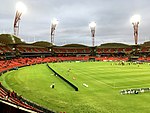Monster Skatepark

Monster Skatepark is a fully outdoor skatepark located in Sydney Olympic Park, New South Wales, Australia. Skaters can use the facility between 10AM and 5PM Monday through Friday and 9AM to 5PM on the weekend.The schedule and site was designed to accommodate related recreational and sporting events, with separate sessions for skate-boarding, scooters and BMX riders, and a variety of ramps and surfaces entirely outdoors. The Monster Skatepark's central feature is promoted by the Government of New South Wales as the nation's "only international ramp facility" with mini and vertical ramps and amenities such as a shop, cafe and music for its users.This skatepark caught fire on 12 May 2017 with the blaze being categorised as a “sixth alarm", which is large and a loud bang was heard with thick smoke covering the roof of the venue. Only 10 percent of the skatepark has been burnt down. The outdoor Vert and Spine ramp and the cafe and retail store have been reopened to the public since the 22nd of December 2018.
Excerpt from the Wikipedia article Monster Skatepark (License: CC BY-SA 3.0, Authors, Images).Monster Skatepark
Orana Parade, Sydney Sydney Olympic Park
Geographical coordinates (GPS) Address Nearby Places Show on map
Geographical coordinates (GPS)
| Latitude | Longitude |
|---|---|
| N -33.84462 ° | E 151.06565 ° |
Address
Orana Parade
2127 Sydney, Sydney Olympic Park
New South Wales, Australia
Open on Google Maps










